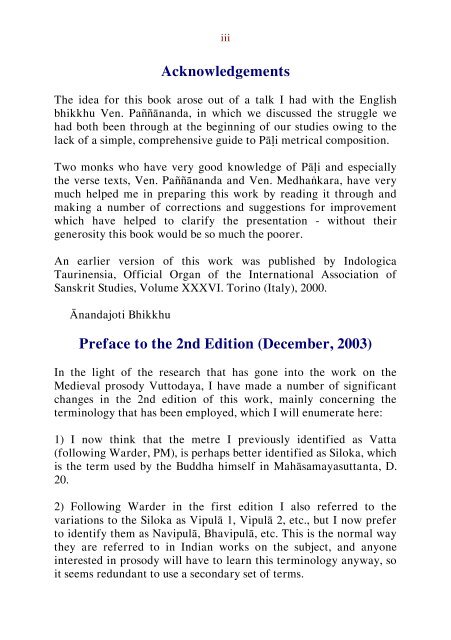An Outline of the Metres in the Pāḷi Canon
A concise but thorough explanation of the metres that are found in the Pāli canon, along with examples and glossary.
A concise but thorough explanation of the metres that are found in the Pāli canon, along with examples and glossary.
Create successful ePaper yourself
Turn your PDF publications into a flip-book with our unique Google optimized e-Paper software.
iii<br />
Acknowledgements<br />
The idea for this book arose out <strong>of</strong> a talk I had with <strong>the</strong> English<br />
bhikkhu Ven. Paññānanda, <strong>in</strong> which we discussed <strong>the</strong> struggle we<br />
had both been through at <strong>the</strong> beg<strong>in</strong>n<strong>in</strong>g <strong>of</strong> our studies ow<strong>in</strong>g to <strong>the</strong><br />
lack <strong>of</strong> a simple, comprehensive guide to <strong>Pāḷi</strong> metrical composition.<br />
Two monks who have very good knowledge <strong>of</strong> <strong>Pāḷi</strong> and especially<br />
<strong>the</strong> verse texts, Ven. Paññānanda and Ven. Medhaṅkara, have very<br />
much helped me <strong>in</strong> prepar<strong>in</strong>g this work by read<strong>in</strong>g it through and<br />
mak<strong>in</strong>g a number <strong>of</strong> corrections and suggestions for improvement<br />
which have helped to clarify <strong>the</strong> presentation - without <strong>the</strong>ir<br />
generosity this book would be so much <strong>the</strong> poorer.<br />
<strong>An</strong> earlier version <strong>of</strong> this work was published by Indologica<br />
Taur<strong>in</strong>ensia, Official Organ <strong>of</strong> <strong>the</strong> International Association <strong>of</strong><br />
Sanskrit Studies, Volume XXXVI. Tor<strong>in</strong>o (Italy), 2000.<br />
Ānandajoti Bhikkhu<br />
Preface to <strong>the</strong> 2nd Edition (December, 2003)<br />
In <strong>the</strong> light <strong>of</strong> <strong>the</strong> research that has gone <strong>in</strong>to <strong>the</strong> work on <strong>the</strong><br />
Medieval prosody Vuttodaya, I have made a number <strong>of</strong> significant<br />
changes <strong>in</strong> <strong>the</strong> 2nd edition <strong>of</strong> this work, ma<strong>in</strong>ly concern<strong>in</strong>g <strong>the</strong><br />
term<strong>in</strong>ology that has been employed, which I will enumerate here:<br />
1) I now th<strong>in</strong>k that <strong>the</strong> metre I previously identified as Vatta<br />
(follow<strong>in</strong>g Warder, PM), is perhaps better identified as Siloka, which<br />
is <strong>the</strong> term used by <strong>the</strong> Buddha himself <strong>in</strong> Mahāsamayasuttanta, D.<br />
20.<br />
2) Follow<strong>in</strong>g Warder <strong>in</strong> <strong>the</strong> first edition I also referred to <strong>the</strong><br />
variations to <strong>the</strong> Siloka as Vipulā 1, Vipulā 2, etc., but I now prefer<br />
to identify <strong>the</strong>m as Navipulā, Bhavipulā, etc. This is <strong>the</strong> normal way<br />
<strong>the</strong>y are referred to <strong>in</strong> Indian works on <strong>the</strong> subject, and anyone<br />
<strong>in</strong>terested <strong>in</strong> prosody will have to learn this term<strong>in</strong>ology anyway, so<br />
it seems redundant to use a secondary set <strong>of</strong> terms.

















